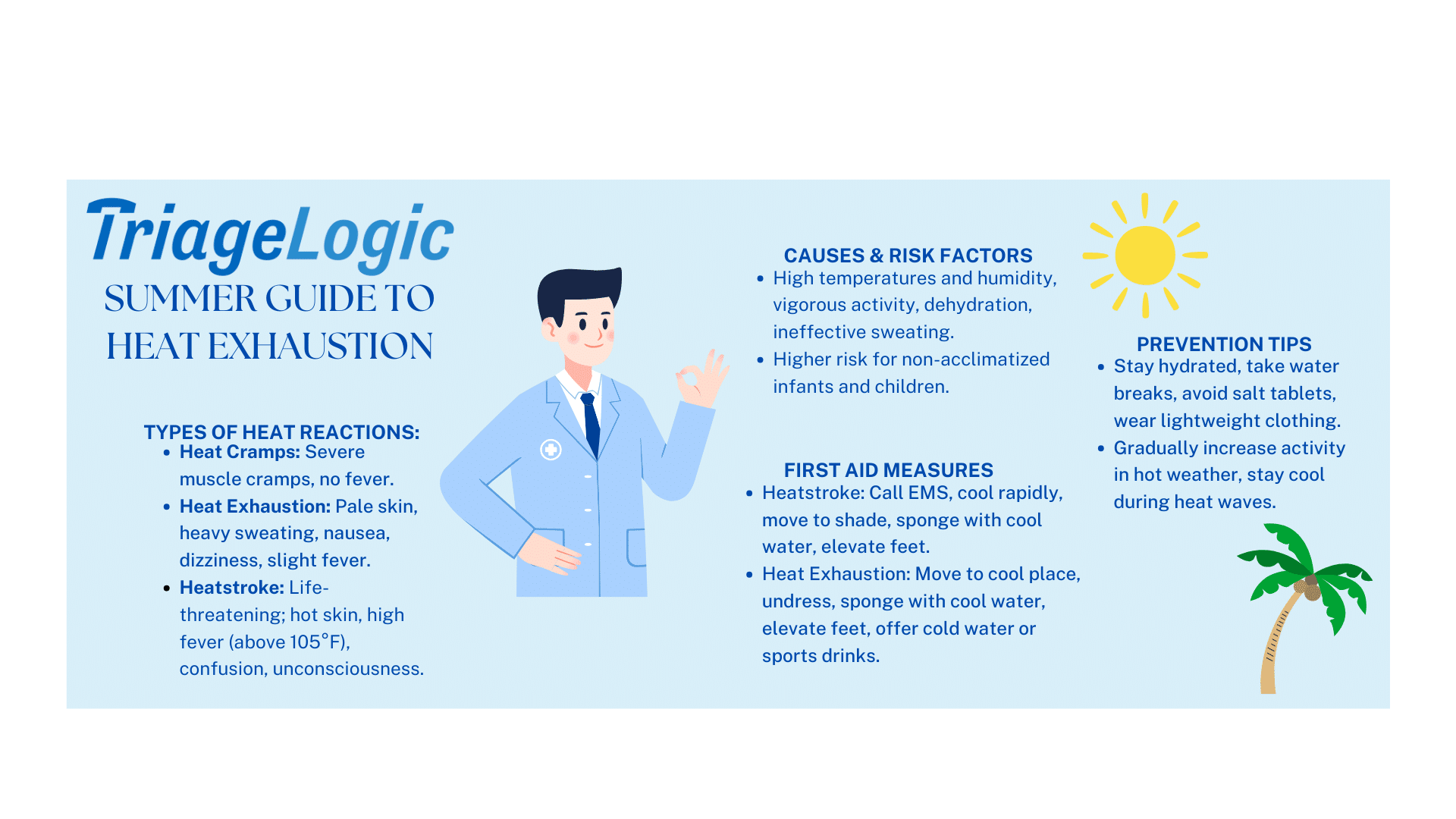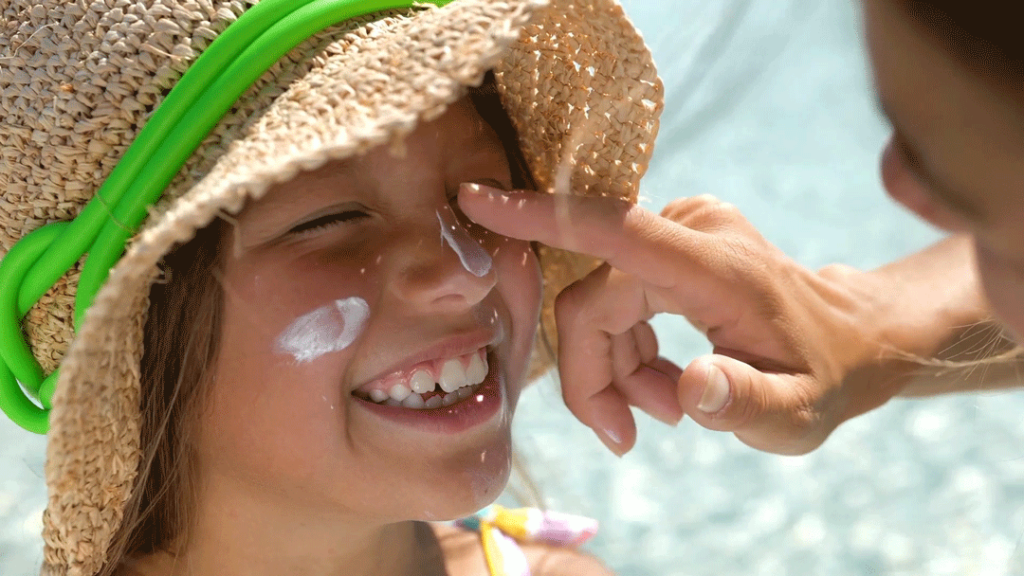Do you have pediatric patients whose parents need help identifying what summertime illnesses their children are experiencing? This article explores heat-related ailments that tend to affect children while outdoors, along with the common — and not so common – symptoms your triage nurses should know about when advising parents.
Common Heat-Related Ailments
An average child can be vulnerable to the heat because of a higher metabolic rate, smaller surface area on their body, and a lower ability to regulate their own body’s temperature. This makes it easier for them to experience conditions like heat exhaustion, heatstroke, dehydration, sunburn, and heat rash.
Heat Exhaustion
Heat exhaustion occurs when the body loses excessive water and salt through sweating.
Common symptoms: heavy sweating; weakness; nausea; vomiting; and fainting.
Less obvious symptoms: muscle cramps; clammy skin that is also cold and pale; a fast but weak pulse; headaches; and extreme fatigue.
When children exhibit these symptoms, triage nurses should recommend to parents that they move their children to cooler places where they can be hydrated and monitored. If symptoms persist, medical attention will be necessary.
Heatstroke
Heatstroke is a severe condition where the body is unable to regulate its own temperature, which then rises rapidly. Heatstroke is a medical emergency and must be treated immediately.
Common symptoms: a high body temperature (above 104°F); nausea; vomiting; diarrhea; and unconsciousness.
Less obvious symptoms: behavioral changes like disorientation; a lack of sweating despite the heat; rapid breathing; and seizures.
In case of suspected heatstroke, triage nurses should advise parents to call emergency services immediately, and try to cool their children down with whatever means is available (cold water, ice packs, etc.).
Dehydration
Dehydration occurs when the body loses more fluids than it takes in.
Common symptoms: dry mouth and tongue; a lack of tears when crying; sunken eyes; and a soft spot on the top of the skull.
Less obvious symptoms: reduced urination; dark urine with a strong odor; dry skin that stays “tented” after being pinched; and a rapid heartbeat.
The easiest ways that children can avoid this condition are to drink plenty of fluids — especially water — and consume hydrating foods like fruits.
Sunburn
Sunburn results from overexposure to ultraviolet (UV) rays.
Common symptoms: red, painful skin that may blister and peel.
Less obvious symptoms: chills; confusion; weakness; and fainting.
To prevent sunburn, children should wear sunscreen with an SPF of at least 30 that they also reapply every two hours. They should also wear protective clothing, and avoid overexposure to the sun between 10 a.m. and 4 p.m.
Heat Rash
Heat rash occurs when sweat ducts become blocked, trapping sweat under the skin.
Common symptoms: small, red bumps, usually in areas prone to sweating like the neck, chest, groin, and elbow creases.
Less obvious symptoms: intense itching; swelling; small blisters; and a prickly sensation.
Keeping the affected areas cool and dry, wearing loose-fitting clothing, and using mild topical treatments can help alleviate symptoms.

How Nurse Triage Can Help
The main difficulty of any nurse triage call is the ability to assess symptoms a nurse cannot physically see. When those calls involve pediatric patients, that difficulty extends to their parents. Nurses must rely on empathy and active listening to help those parents remain calm and provide them with the information they need in order to correctly evaluate the severity of their children’s symptoms.
This is why nurse triage depends on holistic training that anticipates these kinds of situations, while offering nurses the most up-to-date protocols that they can use to evaluate pediatric symptoms. These protocols account for the less obvious symptoms of heat-related ailments discussed above, and allow nurses to quickly advise parents on whether their children need additional medical attention.
It’s also a good idea to share tips with parents that they can use to be proactive and help their children avoid these conditions in the first place.
Stay Hydrated
Encourage children to drink water frequently, even if they don’t feel thirsty. Offer hydrating snacks like watermelon, cucumbers, and oranges.
Dress Appropriately
Choose light-colored, loose-fitting clothing made of breathable fabrics like cotton. Hats and sunglasses can also provide extra protection from the sun.
Use Sunscreen
Be diligent about applying sunscreen to all exposed skin. Reapply it every two hours, or after swimming or sweating.
Take Breaks
Ensure children take frequent breaks in shaded or cool areas. Avoid intense, physical, outdoor activities during hours of peak heat.
Keep an Eye Out for Symptoms
Educate parents on the symptoms above, and encourage them to monitor their children closely during hot weather.
Keep Indoor Areas Cool
Use fans or air conditioning to keep indoor environments cool. If air conditioning is not available, seek out public places like libraries or shopping malls that have it.
Protect Your Pediatric Patients With Nurse Triage
By understanding these common heat-related ailments, recognizing their symptoms, and being proactive, parents and caregivers can help ensure their children stay safe and healthy.
Providing this valuable advice can make a significant difference in the well-being of pediatric patients during the hot summer months. If you need updated nurse triage protocols, or you’d like to talk about outsourcing nurse triage to our 24/7 call center, contact us to talk about a customized program!
About TriageLogic
TriageLogic is a URAC-accredited, physician-led provider of top-quality nurse telehealth technology, remote patient monitoring, and medical call center solutions. Founded in 2007, the TriageLogic Group now serves more than 22,000 physicians and covers over 42 million lives nationwide.





